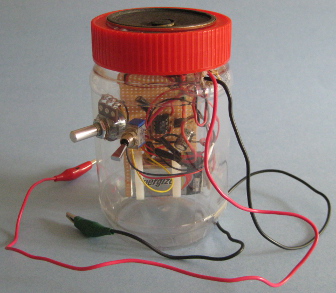The cool thing with crystal radios is that they are solely powered by the incoming radio waves. However, it usually means listening to your AM radio station with an earpiece and even then, depending on the antenna length, ground connection, and radio station, it can be quite hard to hear.
Even though it is cheating, [Steven] decided to make an amplifier for all the different crystal radios he had made over the years. His design, based on an LM386 amplifier was firstly tested on a breadboard and then permanently soldered onto a perfboard. To make the complete system easy to transport, he opted for a peanut butter jar where he embedded the speaker in the cap. The on/off switch and volume controls are mounted on the side, and easy alligator clips are used for the antenna connection.
The final result is not the one shown in the picture above as [Steven] painted the jar black, giving it a sweet look.

















I beg you to carry that on an airplane
Sad sad day when I get first post. Has HAD died on me?
I laughed for at least a good half hour!
Wouldn’t be possible to mechanically amplify the volume? Similar to how you can make a ghetto amp for a phone by placing it in a ceramic bowl.
Or something like this?
http://news.cnet.com/8301-17938_105-57366414-1/nonelectric-iphone-dock-boosts-sound-with-gramophone-horn/
Painted it black? If it were me I’d have filled it with jellybeans.
Fill with jellybeans! I like it. I might just run out and get some and do that!
If you do, please post a photo :)
I went with Jujubes instead. Eating some as I type. :) I’ll try to put the image inline here but if it doesn’t work, just go to the webpage in the description above (I gave you credit.)
[img]rimstar.org/science_electronics_projects/make_crystal_radio_amplifier_for_speaker/crystal_radio_amp_in_a_jujubes_jar.jpg[/img]
That’s awesome! Now it’s can form part of the ultimate bushfire survival radio – listen to the updates on AM, and survive by eating the jujubes in the jar :)
Hey, that’s awesome, thanks for posting the pic! Now you have the ultimate survival radio for bushfire season. Evacuate home, drive somewhere safe, and listen to the updates on AM radio while living off the supply of jujubes :)
I’m trying to think of the funniest filler material. Swedish fish? Live bees?
Live wasps… you can get them by the gram from this guy:
http://hackaday.com/2010/07/01/wasp-sucker-clears-the-air/
Why not making a charging circuit with a super capacitor? While the radio is off, use the incoming radio signal to charge the cap. While the radio is on, the cap acts as the power source for the amp.
If your signal has enough amplitude to charge up a cap for the amp which
has a 4V minimum operating voltage, you won’t need an amp in the first
place.
It’s called energy harvesting, and it works fine. Parasitic effects in run-of-the-mill semiconductors can rob a lot of the bounty, though, so it works better with purpose-built silicon. There are all sorts of sensor motes and stuff using ambient radio signals for power, storing it up until they transmit a data burst.
The lowest power method I know of, is a DC supply to forward-bias the sensor diode. You don’t actually switch it ON – just get it closer to point of conducting. For 0.2V germaniums, about 0.15V will increas sensitivity a lot. If you are using 0.6V silicon diodes, bias them around 0.55V.
You don’t need a lot of current. A decent solar cell will do. Try something about the size of a Tic Tac box (the electronics go inside, glue the cell to the outside).
I definitely have to try these. Thanks for pointing them out. I get asked a lot about using silicon diodes when they’re all they can find, and even though adding power to a crystal radio is cheating, I think a lot of students will find it okay for their projects if it gets it working. The solar cell approach adds a lot to the fun of it.
Time and sunlight finally lined up for me to try biasing the diode as you suggest with a solar cell. I didn’t see any improvement. I tried with the cell connected both ways and I varied the solar cell’s output by controlling how much sunlight it was getting. I had fairly fine control and verfied the voltage with a meter. I retuned the radio each time. Theoretically I don’t see why it wouldn’t work. Maybe I just didn’t find the sweet spot. The stations I could get saw no improvement and I couldn’t get any new ones. Also, there was no change in volume in the noise. I’ll keep hacking away at it.
Reminds me that I need to build another crystal radio